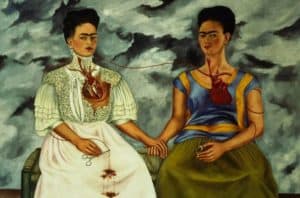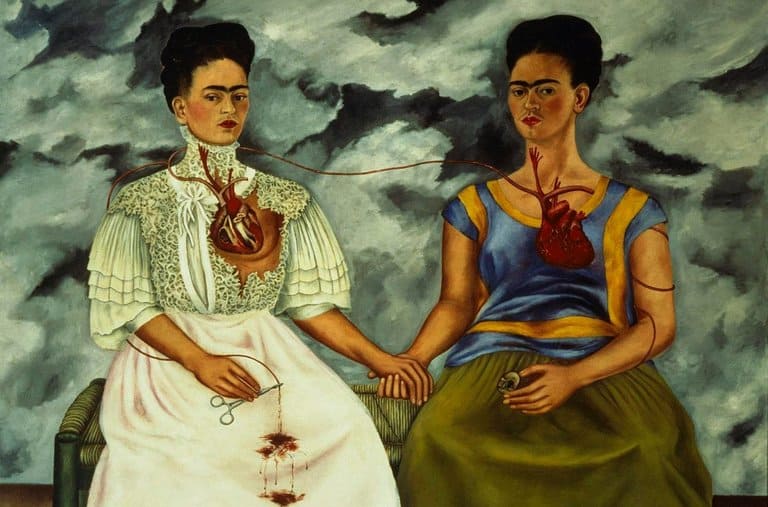 This past weekend was Mother’s Day, or as it is known in our house, the one day of the year my family has to accompany me to an art museum. I chose to go to the Museum of Fine Arts (MFA) in Boston, which is showing an exhibit through June 16th entitled Frida Kahlo and Arte Popular. (The “Arte Popular” refers to traditional Mexican folk art, which Kahlo collected and surrounded herself with.) The exhibit combines Kahlo’s own art with the arte popular that she loved, and asks viewers to consider how these objects impacted her art and aesthetic.
This past weekend was Mother’s Day, or as it is known in our house, the one day of the year my family has to accompany me to an art museum. I chose to go to the Museum of Fine Arts (MFA) in Boston, which is showing an exhibit through June 16th entitled Frida Kahlo and Arte Popular. (The “Arte Popular” refers to traditional Mexican folk art, which Kahlo collected and surrounded herself with.) The exhibit combines Kahlo’s own art with the arte popular that she loved, and asks viewers to consider how these objects impacted her art and aesthetic.
Frida Kahlo is one of the most celebrated artists of the 20th century. She has joined the ranks of Van Gogh and Picasso among others, who are so ubiquitous you don’t even have to know much about art to know who they are. Her work is on a $10 poster in some kid’s dorm room, as well as t-shirts, handbags, toys, and even lipstick. She is no longer just a famous artist, she is pop culture.
Because of this popularity, it can be tempting to dismiss Frida. To say she had a major impact on me seems almost embarrassing; I might as well say “I like art.” Everyone likes Frida, and I tend to be pretty uncomfortable liking something that is extremely popular. If it is everywhere, it becomes less interesting. But of course, this is completely ridiculous – Frida Kahlo is beloved for a reason. Her art is extremely personal. It can be brutal and violent, showcasing her distress for all to see. She is beautiful and powerful; she is pain and beauty. Almost every female artist admires her.
One of the interesting things about Frida is that we don’t just love her art, we love her. We know who she is and what she looks like just as much as we know her painting The Two Fridas. This was intentional and by her design. Her husband, Diego Rivera, was already a famous Mexican painter when her art was recognized and began showing, and she knew what journalists and collectors thought of an artist could be as influential as their work itself (if not more.) So she constructed Frida “the artist” – the face she wanted the world to see.
As a child, her family changed her birth year from 1907 to 1910 to hide the fact that she was developmentally behind when she was entering school, due to illness. As an adult, she kept the 1910 birth year not because she wanted to be seen as younger, but because that was the year of the Mexican Revolution. As a young woman, Frida defied convention and dressed as a man in tailored suits and with short hair. But later, she would commission seamstresses to create elaborate copies of traditional folk dresses that she was sure to be photographed in. She wanted to be seen as a symbol of Mexico, a woman of the people. She would be the embodiment of the strong Mexican Revolutionary.
When Frida Kahlo is talked about, the conversation usually centers around both how personal her art is and how tragic her life was. She poured all of her hopes and sorrows into her art, and pushed the boundaries of how brutal and honest she could be. We look at her work and feel like we know her because she is seemingly showing us pieces of her very soul.
But the MFA show is a little different – a little left of center. We know Frida, but we also know what Frida wanted us to see. She constructed the image of herself with careful thought and planning. Some may see that as a lie – a mask, and feel like we have somehow been cheated out of knowing who she really was.
I like to think a little more hopefully about it. Frida could not help illness and accidents, betrayals and loss. But she surrounded herself with the things she admired and loved. She was a strong, intelligent woman who made herself into the symbol she wanted to show the world. Frida’s work continues to show us that we cannot avoid pain, but we can mold it into something beautiful.
Reading List:
Frida Kahlo: An Illustrated Life by Maria Hesse
Frida: A Biography of Frida Kahlo by Hayden Herrera
The Diary of Frida Kahlo: An Intimate Portrait
Frida Kahlo: The Paintings by Hayden Herrera
Frida Kahlo at Home by Suzanne Barbezat
Nicole Guerra-Coon is the Assistant Children’s Librarian at the Morrill Memorial Library in Norwood, MA.




